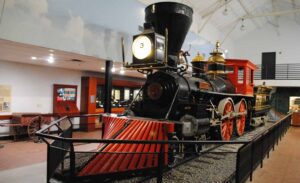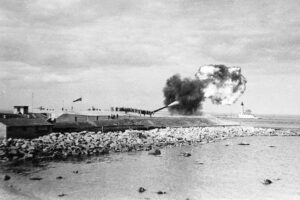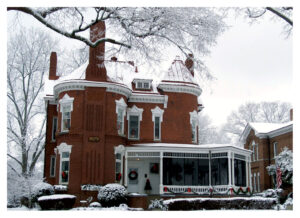Written By: Lt. Col. Edward B. (Buck) Cummings

By the time the United States entered the Great War in Europe in 1917, the Western Front had become a bloody landscape scarred by more than three years of inconclusive trench warfare. Unlike World War II, which raged across Europe, North Africa, and parts of Asia and the Pacific, World War I had largely confined its enormous destruction to a narrow but lengthy front in Western Europe extending unbroken from the Mediterranean to the North Sea. Thousands of artillery batteries and heavy crew-served machine guns, such as the German Maxim, produced carnage of an unprecedented magnitude all along the Western Front.
The American Expeditionary Forces (AEF), led by GEN John J. “Black Jack” Pershing, arriving with elan and high enthusiasm, hoped to change the character of the war and to force a breakout by the exhausted Allies using maneuver. Critical to the success of any attempt to break through the imposing German defenses was an assurance that assault troops would have overwhelming firepower upon reaching the German lines. “Over the top!” was too often the last command heard by Allied troops as they scrambled out of their trench lines, their bolt-action rifles with fixed bayonets carried at “high port” into the withering German machine gun fire. The few who reached the German lines realized that they lacked an automatic weapon that could be carried by one man to augment the limited and slow firepower provided by bolt-action rifles.
In the autumn of 1918, a powerful new American weapon was introduced to provide assault troops that type of weapon: the Browning Automatic Rifle, then and thereafter known simply as the BAR (not “bar”). The BAR gave attacking troops a genuine tactical advantage in the offensive. It became a legendary weapon that saw service in World War I, World War II, Korea, and Vietnam. Even in recent Third World clashes, BARs are still sometimes used in combat, giving the BAR a service record eclipsed in length perhaps only by the famous Colt .45 Automatic Pistol, Model 1911. In his memoirs titled My Experiences in the World War, published in 1931, Pershing wrote about the pressing need at the beginning of the war for the United States to develop automatic weapons:
The development of the machine gun as an infantry weapon, following the experience of the Russo-Japanese War had been carried to a high degree of perfection, especially in the German Army, where its value was more fully appreciated than among the Allies. The question of adopting new types of machine guns and automatic rifles for our Army had been discussed at home for years and test after test had been made…The result was that when we entered the war no conclusion regarding the best make of gun had been reached…Not only were we without sufficient machine guns but also our organization tables did not anticipate their use in anything like the numbers employed by the enemy.
Thousands of German crew-served, water-cooled Maxim 8mm machine guns had taken a fearsome toll along the Western Front when the United States finally entered the war in April 1917. The German Maxim gun, called the “Devil’s Paintbrush” for its wide swath of deadly and long-sustained rate of fire, was a formidable weapon capable of firing without interruption as many as 2,000 rounds before all the water in the cooling jacket enveloping the barrel boiled away, requiring that the jacket be refilled. At the start of the war, Germany had over 12,000 of these weapons available for field use. They were devastating defensive weapons when deployed in “nests” among the trenches, with interlocking fields of fire along a continuous front.
The BAR gave AEF assault troops the firepower needed to neutralize the German trenches upon reaching them. Patented in 1917 by renowned gun designer John Browning and adopted by the Army in May 1918, the BAR was introduced to American front line units in September 1918 as the M1918. Front line commanders, at first reluctant to employ the BAR in situations where it could be captured and copied by the enemy, were soon convinced that the firepower advantage far outweighed the risk of capture and copying. Firing the powerful .30-06 ammunition also used in the Springfield M1903 rifle, the BAR added great firepower to the leading assault units in the last major campaigns of the war, St. Mihiel (September 1918) and Meuse-Argonne (September-November 1918).

The BAR is a gas-operated, air-cooled, open-bolt, magazine-fed automatic rifle. Although often used as a light machine gun, it was not designed as such. It is not a submachine gun or an assault rifle. The shooter could not change its barrel, which meant that its capability to provide sustained automatic fire was limited. A high rate of fire requires that an automatic weapon’s barrel be changed at various intervals to prevent the barrel from overheating. It was advertised as being “light” and “highly portable,” but the infantryman who carried the weapon, with bipod and a web belt with extra magazines, would disagree with that description. The weapon with its cartridge belt and extra magazines weighed approximately forty pounds. The weapon itself weighed approximately nineteen pounds empty, had an air-cooled 24-inch barrel, a detachable 20-round box magazine inserted from the bottom of the receiver, and an effective range of over 600 yards.
When loaded with a full 20-round magazine, it weighed just over twenty pounds. The original BAR developed for World War I was designed to fire either semiautomatically or fully automatically. A later model, adopted in 1940 and designated the M1918A2, eliminated the M1918’s semiautomatic fire capability. Instead, it had two rates of fully automatic fire that the gunner could select: 300-450 rounds per minute or 500-650 rounds per minute. The M1918A2 also had a bipod and flash suppressor at the muzzle of the weapon and a hinged buttplate that folded over the butt of the stock. When the buttplate was raised, it protruded to the rear and over the shooter’s shoulder; its purpose was to keep the rifle firmly on the shooter’s shoulder to help control automatic fire. The original M1918 had neither a buttplate nor a bipod.
The BAR, in all its variants and adaptations over its more than sixty years’ employment by the United States Army, Marine Corps, and National Guard, was always an “open bolt” weapon. Since it was air-cooled and generated great heat in fully automatic fire, it had to be an open bolt weapon to prevent “cook offs.” Open bolt meant that at the end of every firing cycle and upon trigger release, the last cartridge casing was ejected as the bolt moved to the rear, where it remained locked until the trigger was again pulled. Having the bolt locked to the rear of the chamber facilitated cooling of the barrel and breech area. When the trigger was again pulled the bolt traveled forward, stripping a new round from the magazine and chambering it.
If the weapon were “closed bolt,” after the trigger was released on a weapon that had cartridges remaining, the bolt would be forward and closed against a chamber containing a loaded cartridge. The heat from the chamber and barrel could be sufficient to detonate the round, an unintended and dangerous firing known as a “cook off.” Many BAR men modified the weapon. The most frequent modification was removing the two-pound bipod, which saved weight and also made the weapon more likely to be used in a constantly moving scenario. The original World War I BAR cartridge belt had three pouches on the left side, each of which held two magazines. The right side had two pouches for two magazines each, giving the shooter a total of ten magazines in the belt.
In place of the right front pouch was a metal cup used to support the weapon firmly when firing it from the hip. The shooter simply inserted the butt of the BAR into the cup so that the BAR was braced as the shooter stood to fire. After World War I, the right side cup was removed from the belt. The new belt configuration had three pouches on each side, giving the shooter a total of twelve magazines. The BAR man now had 260 rounds available for his use: twelve magazines with twenty rounds each in belt pouches plus a magazine in the weapon. With additional ammunition nearby, carried by an assistant, and the ability and training to reload his weapon quickly, the BAR man was truly an inspiring addition to any assault unit.
The high penetration power of the BAR was a welcome advantage in jungles or forests. Firing .30-06 ammunition, the BAR would kill even after blasting through trees and logs that would routinely stop hand grenade fragments or lower velocity .45 caliber rounds used in submachine guns and pistols.
The BAR did have several disadvantages. Its powerful .30-06 cartridge produced strong recoil, which made the weapon climb in fully automatic fire and caused the shooter to often miss the target at the end of a burst. Unlike its chief rivals, the British BREN and the Japanese Nambu, both of which had 30-round magazines and changeable barrels, the BAR’s magazine capacity was only twenty rounds and its barrel could not be changed. This limited its capacity for fully automatic fire. Residue fouled the BAR’s gas-operated functioning. Fully aware of the residue problem, BAR men kept their weapons thoroughly cleaned.

Two aspects of the BAR in combat are noteworthy. First, the casualty rate for BAR men was high since a general rule of combat is to eliminate enemy gunners armed with automatic weapons. As a result, BAR men were priority targets for enemy fire. Second, numerous Medal of Honor citations from World Wars I and II and the Korean War mention the BAR. Perhaps the greatest shooting feat was accomplished by Army PFC Henry Schauer, who earned a Medal of Honor in Italy while serving with the 3d Infantry Division in 1944. Standing in the face of enemy fire, he killed five German snipers with his BAR. The snipers were at different distances from him. Amidst enemy shelling and small arms fire, he killed two machine gunners and two Germans who ran to replace their dead comrades. The German runners were sixty yards from him. Reloading, he then killed four Germans who were 500 yards away. The next day, in the face of enemy tank and small arms fire, he killed four members of a German machine gun crew at eighty yards with one BAR burst.

Between the World Wars, both law enforcement agencies and criminals used BARs. Perhaps the most notorious user of the BAR during this time was Clyde Barrow of the notorious “Bonnie and Clyde” gangster pair, who used BARs, stolen from National Guard armories, during several robberies in the 1930s. The seven lawmen who killed Bonnie Parker and Barrow used government-provided BARs, as well as shotguns and pistols, during the ambush that killed the pair in Louisiana on 23 May 1934. Four BARs stolen by Barrow from the armories were found in his car after the ambush. An early personal connection with the legendary weapon was formed for the author of this article in 1961 when his father’s boss, Joe Bucheit, came to the author’s Ithaca, New York, home to visit.
Bucheit was a Marine Corps BAR man in the Pacific Theater during World War II. He had turned his head in response to a warning shouted from one of his buddies as several Japanese soldiers firing weapons emerged from a cave. A bullet, which might have hit squarely between his eyes had he not turned after hearing the shouted warning, nicked the bridge of his nose and tore out one of his eyes. Feeling no pain and thinking only that a splinter of rock had momentarily blinded him, he opened fire with his BAR, cutting down all four Japanese soldiers with one long burst. Thirty minutes later during a lull in combat, he asked a Navy corpsman to look at his eye. “It’s gone, Joe, and you are going home,” the corpsman told him. Bucheit gave a remarkable testimonial to the weapon and his own courage. “The BAR was my best friend in combat, but I felt like I got an easy ticket home with my third wound, only losing my eye.”
Bucheit had survived his third Pacific island landing assault, beating the odds for anyone carrying a BAR.
The author’s oldest brother, Jack Cummings, was one of the first U.S. Marine officers in Vietnam in 1965 and a lieutenant leading a Combined Action Platoon of U.S. Marines and South Vietnamese Army soldiers. Jack recently sent the author his written recollections of combat in Vietnam. “Our battalion had several Vietnamese BAR men who served with us in combat. I remember one of them standing tall on a rice paddy dike and opening up on a Viet Cong position with his BAR. I never saw a braver man, or a more awesome one-man weapon.”
With all the advanced weaponry available to the infantry today, a modern soldier would have difficulty looking back and appreciating the simple equipment provided to the American doughboys of World War I as they fought what was optimistcally referred to as the “war to end all wars.” The Browning Automatic Rifle, when it first arrived in France, must have caused a sensation since it was a weapon so advanced for its time. Even ninety years after its introduction, the BAR’s legacy remains, with its superb design, high power, and reliability securing its prominence in small arms history.





